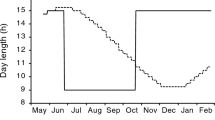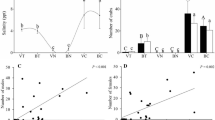Abstract
THE successful adaptation of juvenile Atlantic salmon to sea-water requires a prior physiological ‘metamorphosis’—parr–smolt transformation1. The occurrence of this change appears to depend in part upon age, and in part upon the complex of factors controlling the growth-rate of the parr2. In addition to external evidences of parr–smolt transformation such as loss of parr marks, decrease in condition factor and deposition of guanine there must also be some variation in biochemical systems associated with the regulation of body electrolyte-levels relative to those of the environment. Evidence for such changes may be seen in the changing plasma chloride-levels of two migratory salmonids, Oncorhynchus masou, and Salmo gairdneri, during transition from parr to smolt stages3. Several investigators have also reported marked development of Keys–Willmer cells, units thought to have an ion secretory role, in a number of species of salmon prior to downstream migration4. Fontaine, however, could find no significant variation in blood chloride-levels of smolting Atlantic salmon, although a decrease did occur in tissue concentration5.
This is a preview of subscription content, access via your institution
Access options
Subscribe to this journal
Receive 51 print issues and online access
$199.00 per year
only $3.90 per issue
Buy this article
- Purchase on Springer Link
- Instant access to full article PDF
Prices may be subject to local taxes which are calculated during checkout
Similar content being viewed by others
References
Fage, L., Bull. Inst. Oceanog., Monaco, 225, 1 (1912). Huntsman, A. G., and Hoar, W. S., J. Fish. Res. Bd. Canada, 4, 409 (1939). Parry, G., Nature, 181, 1218 (1958).
Elson, P. F., Canad. Fish. Cult., 21, 1 (1957).
Kubo, T., Bull. Fact. Fish., Hokkaido Univ., 6, 201 (1955). Houston, A. H., Canad. J. Zool., 37, 729 (1959).
Hoar, W. S., Univ. Toronto Biol. Ser., 59, 1 (1951). Nishida, H., Sci. Rep. Hokkaido Fish. Hatch., 8, 33 (1953).
Fontaine, M., C.R. Acad. Sci., Paris, 232, 2477 (1951).
Pickford, G. E., and Atz, J. W., “The Physiology of the Pituitary Gland of Fishes” (N.Y. Zool. Soc., 1957). Hoar, W. S., “Endocrine Organs”, Chap. 6 in the “Physiology of Fishes”, 1, ed. by Brown, M. E. (Academic Press, 1957).
Fontaine, M., and Hatey, J., C.R. Acad. Sci., Paris, 239, 319 (1954).
Koch, H. J., Evans, J. C., and Bergstrom, E., Nature, 184, 283 (1959).
Author information
Authors and Affiliations
Rights and permissions
About this article
Cite this article
HOUSTON, A. Variations in the Plasma-Level of Chloride in Hatchery-reared Yearling Atlantic Salmon during Parr–Smolt Transformation and following Transfer into Sea-Water. Nature 185, 632–633 (1960). https://doi.org/10.1038/185632a0
Issue Date:
DOI: https://doi.org/10.1038/185632a0
This article is cited by
-
Transepithelial ion exchange in smolting atlantic salmon (Salmo Salar L.)
Fish Physiology and Biochemistry (1988)
-
Osmoregulation during adaptation to fresh water in the euryhaline teleostAphanius dispar r�ppell (Cyprinodontidae, pisces)
Journal of Comparative Physiology (1973)
-
Der einflu� von temperatur�nderungen auf den Ionen- und Wassergehalt in blutplasma und geweben von Tinca tinca
Marine Biology (1970)
-
An Electron Microscope Study of the ‘Chloride-Secretory Cell’ of Salmo Salar L., with Reference to Plasma-Electrolyte Regulation
Nature (1961)
Comments
By submitting a comment you agree to abide by our Terms and Community Guidelines. If you find something abusive or that does not comply with our terms or guidelines please flag it as inappropriate.



